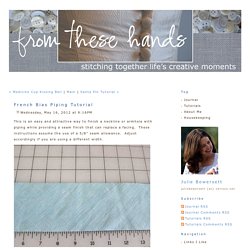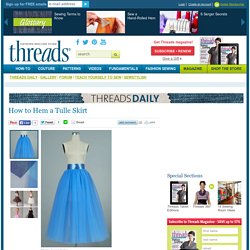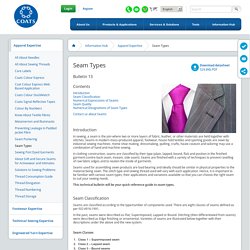

A Guide to Coverstitch Machines Rolled Hem Basics & How To - The Sewing Loft. Creating a Faced Split Hem A Guide to Sewing Denim How to Sew Stripes and Stripe Match Every Time. If, like me, you love wearing stripes, you really need to learn how to stripe match.

Look at most cheap high street stripey clothing to see great examples of awful (non existent) stripe matching. Argh, it sets my teeth on edge!! If you’re making your own clothes you have the power to change that and get beautifully matched stripes every time. I’m going to show you some of my simplest stripe matching tips so that you can achieve results like these. Spoiler: there are no shortcuts. I’ll show you how to ensure perfectly matching stripes at every stage of making your garment: Planning StripesStripey LayoutsCutting StripesSewing Stripes Fact – some stripes are easier to sew than others. In these examples, the stripe on the right may just tip you over the edge if you haven’t had a bit of experience with stripe matching. The second thing to consider (more in terms of fabric consumption and cutting) is whether your stripe is symmetrical.
Waffle Patterns // sewing patterns for ladies. Seamwork Magazine. Bringing you outstanding sewing, quilting, and needlework tutorials since 2005. Deborah Moebes of Whipstitch is an excellent sewing instructor who showed us how to make In-Seam Pockets with French Seams.

She also taught us how to Be a Better Craft Teacher in her six-part series (find links to all posts in the series here). We asked Deborah to tell us a little about her Slow Sewing experiences for our ongoing series. Here are her thoughts on why it’s worth it to sew a hem by hand! Deborah has lots of great links for further reading too… I love a good double-turned hem sewn on the machine. They’re quick and simple and easy, and work for almost any garment. Hand-sewn hems are almost always special. A hand-sewn hem can be a double-turned hem– the process of pressing up the hemline and preparing the garment to be hemmed is identical. The other major benefit to hand-sewn hems is the ability they give you to make the stitches on the exterior of the garment invisible. A needle for your thoughts: Become the Boss of Overlocking. Hi there!

Overlocks/sergers can be scary and intimidating at first glance. Okay, they are still scary the second time you look at them but they are actually your best friend when you buck up and tame that beast of a machine. How to Ladder Stitch: Joining Softie Parts with Invisible Stitches - While She Naps. Two Understitching Techniques. In "Understitch by Hand" from the SewStylish Fall 2014 issue, couture expert Susan Khalje shares fundamental hand-understitching techniques to help improve your sewing.

In this Web extra, Susan shares two more understitching methods, one by machine and one by hand. Machine UnderstitchingQuick to learn and simple to do, understitching by machine instantly gives your garments a professional appearance. Machine understitching can be applied to a garment facing or lining, with the same process applying to both. 1. Sew the facing (or lining) to the garment. 2. 3. Sew Better with Staystitching Fundamentals. Be careful not to stretch or straighten a curve while staystitching.

Mary Ray Staystitching should be done directionally with the fabric's grain, which is generally from the top to the bottom of a neck or armhole edge. Start at the shoulder and sew to center front, flip the piece over and repeat. V-necklines should be staystitched because of their angular lines and reinforced because they need to be clipped at the V. This can be done in one operation, pivoting at the point. Photo: Mary Ray Although one of my favorite parts of sewing is creating interesting surface design, I'm well aware that it's the underpinning steps in the process that make a garment truly successful and wearable. One of those essential steps is staystitching-a row of stitches on a single fabric layer that prevents a curved or angled edge, because they are cut across the bias, from stretching during the construction process. Sew directionally, with the grain, to prevent distortion.
Hems. Basic Seams. Basic Seam A 3/8 inch seam is the most basic seam to attach two pieces of fabric together.

Pinked Seam You can use pinking sheers to finish the edges of a basic seam when you don't have a serger. Serged Seam Serged seams are best for stretch fabric, woven seams and any basic seam that does not need to open. It you don't have a serger, try using the zigzag stitch on your home machine. Bound Seam This seam is commonly found inside of unlined outerwear. Basic Hems. From these hands - Tutorials - French Bias Piping Tutorial.
This is an easy and attractive way to finish a neckline or armhole with piping while providing a seam finish that can replace a facing.

These instructions assume the use of a 5/8” seam allowance. Adjust accordingly if you are using a different width. Begin by cutting a bias strip of fabric 3 inches wide and the length needed for the edge you wish to apply the piping to. Piece the strips together if necessary. Fold the strip in half lengthwise, matching long cut edges, and press. Cut a piece of cording a little longer than the strip of fabric. Place the cording down the center of the folded strip and make a second lengthwise fold, encasing the cording. Sewing On Leather: Stitching and Seams. Now that I've confessed to fusing all kinds of fusibles to my leather with an iron, it's time to talk about how I'm sewing things together.

There's been a bit of chatter in the blogosphere recently about how useful (or not) tutorials are when written by novices or those who don't know good technique. I've never written a tutorial, but I do like to blog about the techniques that worked for me as a part of my sewing journey. So, I feel the need to add this disclaimer: this is what is working for me on my very first leather project and with the tools and leather that I am using.
I am not an authority; I'm a learner. And I welcome any and all comments and suggestions on better techniques. How to Hem a Tulle Skirt. James Keller Simplicity Photo: James Keller Tulle skirts are having their fashion moment.

Tutu-like garments are shown styled for both casual and dressy occasions and, in every case, are fun to wear. Making your own isn't difficult. Fabric and design: Tulle is a thin, net fabric, typically synthetic but also available in silk. How to Sew Lace Seams. Seam Types - Reference Guide to Seam Types. Bulletin 13 Download datasheet529.8Kb PDF Contents IntroductionSeam ClassificationNumerical Expressions of SeamsSeam QualityNumerical Designations of Seam Types Contact us about Seams Introduction In sewing, a seam is the join where two or more layers of fabric, leather, or other materials are held together with stitches.

In clothing construction, seams are classified by their type (plain, lapped, bound, flat) and position in the finished garment (centre back seam, inseam, side seam). Seams used for assembling sewn products are load bearing and ideally should be similar in physical properties to the material being sewn. How to get a level hem Have you ever put together a garment – whether it’s a dress, a skirt, pants, or a blouse – only to notice afterwards that the hem seems to be drooping in certain areas?
It’s not necessarily the fault of the pattern. There are a few reasons you might experience this, but it’s an easy one to fix if you just follow a few simple steps every time you hem. Why hems droop There are two main reasons you’ll get an uneven hem: 1. Sew a Hand-Rolled Hem.